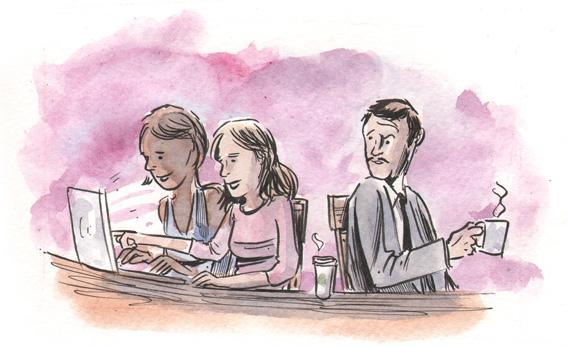Imagine the following scenario. You—and in this scenario “you” are a celebrated young writer who just so happens to be a woman—have written your latest novel off-recipe. You never bothered with the conventions of plot, climax, dénouement. In fact, you attack the idea of fiction itself, by incorporating the personal histories, quirks, and even actual names of some of your friends, into what you still call “a novel.” You take years to write it. And then, when you present the novel to the editor of your last book, a man who will soon be put in charge of one of the country’s most prestigious literary journals, he not only says that he himself will not publish it but tells you that, word to the wise, it might be best if it never saw the light of day at all.
You find another editor, a woman. The book comes out, a couple of years later than anticipated, because the business of publishing literary fiction is a thing that cannot be rushed. Young women flock to it. They declare that everyone could benefit from reading it. Perhaps because it is listening for that call, no less than The New Yorker decides to review it. (They ignored your last book.) And not just any review: They assign it to one of the last rock-star literary critics left, a man so acclaimed he can plausibly write a book about how “fiction”—not just one novel, but all of them—works. He concludes that your book does not, in fact, work. And though he just recently raved about a book very similar to yours (that one was written by a man, but one of the same age and same meandering disposition, one who also mixed fiction and fact), the critic’s lukewarm review is written with the air of one holding the offending item out at arm’s length, sniffing warily.
Sheila Heti may recognize this story I have been telling, because it is taken from her life, just like her new novel, How Should a Person Be? The book is an attempt to answer that titular question—and as something of a philosophical investigation, it is bound not to be everyone’s travel mug of fair-trade Darjeeling. The intrigue, here, is that it has prompted these influential, “serious” men to plant themselves so firmly in its way. This looks all the more strange when you consider that one of the novel’s refrains, one I already find myself repeating at cocktail parties, over dinner, to myself as I write this review, is this: “He’s just another man who wants to teach me something.”
The first character to utter those words is Margaux Williamson (a character based on Margaux Williamson). Her friendship with Sheila (the character, not the author—not exactly, anyway) is the closest thing the story has to a driving narrative force. This is a story of girl meets girl, girl talks to girl, girl talks to girl again, girl buys same dress as girl, girl makes up with girl, and so forth. There are other friends in the constellation Heti presents, but they are dwarves to Margaux’s supergiant, at least in Sheila’s ordering of the universe. And it’s in her relationship with Margaux, a painter, that Sheila investigates, and reinvestigates, and reinvestigates, the question that obsesses her. This is not the kind of book you can really spoil, but I will say, right off the bat, that the process of asking turns out to be just as important as the answer.
You could call this navel-gazing—or, if you are James Wood, you can call the author’s emotional age into question. An author invites that critique by keeping the world of her book very small. But a critic needs to pause, at least, before simply dismissing a writer’s unapologetic focus on the intellectual effects of female friendships. It is no accident that Sheila’s sexual affair with a lout named Israel is not of interest to Margaux, who is “made impatient by conversations about relationships or men.” That echo you hear is of the “Bechdel test,” which applied to movies asks whether the film contains a conversation between two women about something other than a man. The world of books, lacking the bombast imparted by the Hollywood machine, has largely been excused from such rigid measures. But the truth is that literature has its own line to tow here. In “serious” fiction of the sort reviewed by “serious” people, the subjects discussed by women tend not to be so wide and abstract as the nature of “life, the universe, and everything” (to steal a man’s phrase, because there are few others available). Pointing to anything made primarily by women—Girls, Bridesmaids, Swamplandia!—and declaring it a triumph for all women everywhere is an increasingly popular pastime. But I’m not willing to plant a victory flag until the kinds of conversations Sheila has with Margaux feel much less rare—or, at least, provoke a reaction in male critics other than the dubious rubbernecking they currently inspire.
But wasn’t Girls adored by high-minded guys, you might ask? Comparisons between How Should A Person Be? and Lena Dunham’s HBO series are inevitable, but not terribly apt—if only because Dunham’s interests are so much narrower than Heti’s. Dunham’s Hannah Horvath is not the type to ask many questions about the nature of art: She is a solipsist uninterested in real questions about solipsism. Her creator is too preoccupied with getting to the next sight gag—or, put differently, the next way to mediate her (admittedly original) voice into something more palatable. Sure, certain gatekeeper critics loved Girls—Hilton Als was particularly unable to contain himself, waxing rhapsodic over Jemima Kirke’s lips—but it didn’t challenge them in the way that Heti’s book does.
Heti’s closer analogue might be Fiona Apple, who wrote a beautiful, musically virtuosic album with a long title that she fought for because it was what suited her. And now every piece about Apple must begin with a thicket of speculation, ventured under the cover of artistic respect, that she is crazy. Even Apple’s noticed it. “Because that’s what you do with me, right?” she asked Jon Pareles of the New York Times. Even when someone admits that what Apple has to say is worth hearing, they can’t resist the armchair psychologizing. Push the envelope too far as a female artist, and you may only earn an ocean of ink expressing concern for your delicate constitution, amounting to a caution against playing on traditionally male wavelengths.

Photo by Sylvia Plachy Color.
Like Apple, Heti knows what she’s doing—much of the pleasure of How Should a Person Be? comes from watching her control the norms she’s subverting. Take what even Heti’s most fervent acolyte must admit is the loose, sometimes bland quality of the conversations in this book. To simply call them banal and stop there ignores (or misunderstands) the strange way this book works. When you turn those conversations over (and over) in your mind, you’ll find something else going on. Sheila herself tapes her conversations with Margaux, transcribing them into a sort of scripture. This is a novel that wonders if the ugly can be beautiful, if there is clarity to be found in the drifting. The occasional banality of the conversations is a deliberate challenge, not least to the notion of banality itself.
So sure, How Should a Person Be? may not be an ideal beach read, but why does that matter on the level of serious art? In one of the novel’s intermittent moments of sparkling lucidity, Sheila observes that, “Had anyone suggested at the time that it would not be the Egypt of the pharaohs that would survive and change the moral landscape of the world, but instead a group of Hebrew slaves, it would have seemed the ultimate absurdity.” She and her friends, the slaves of the metaphor, must struggle with the fact that, for the moment, their language is that of the underdogs, and is ugly to the common reader. But Heti has reason to hope that some readers will take the seriousness and precision of her book on faith, because it is, frankly, what artists upending orthodoxies have always expected.
Zadie Smith, in an essay about David Foster Wallace—both of them writers whose work has not always met with James Wood’s approval—argued that Wallace, for all of his difficulty, was simply looking for another level of understanding, a higher awareness than the preoccupations of the modern world demand. “Strange to say it,” she wrote, “but Wallace wanted faithful readers.” Perhaps the best thing to say about Heti’s book is that it demands the same. (Certainly the gurulike quality that audiences at readings ascribe to her is reminiscent of Wallace.) In the famous interview off which Smith based her argument, Wallace himself suggested it was all a matter of trust. It “seems like the big distinction between good art and so-so art lies somewhere in the art’s heart’s purpose,” he said, “the agenda of the consciousness behind the text.” On every page of How Should A Person Be? that agenda—to make you ask questions, to keep your mind whirring on this whole question of being—is palpable. Whether you find Heti’s particular expression of it powerful or merely tedious cannot be predicted in advance. But simply being open to the possibility that a person like Heti could teach you something about it? That is entirely up to you.
How Should a Person Be? by Sheila Heti. Henry Holt.
See all the pieces in this month’s Slate Book Review.
Sign up for the Slate Book Review monthly newsletter.
